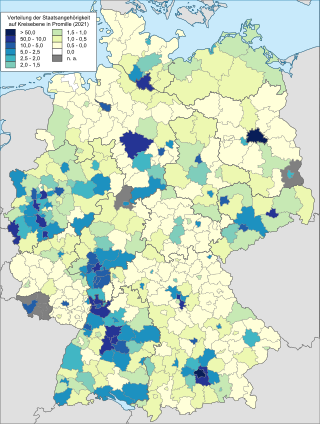Indians in Germany
Ethnic group From Wikipedia, the free encyclopedia
The Indian community in Germany includes Indian expatriates residing in Germany, as well as German citizens of Indian origin or descent. In 2009, the German government estimated that the number of people of Indian descent residing in Germany at 110,204, of which 43,175 people were holding an Indian passport, while 67,029 were holding a German passport.[2] In 2023 the number stood at about 273,000 of Indian descent of which 198,000 had a migration background.[3] According to the Federal Statistical Office the number of nationals from India is the second largest in Germany from either South, South East, East or Central Asia, only below the number of nationals from Afghanistan.[4]
This article includes a list of general references, but it lacks sufficient corresponding inline citations. (August 2017) |
 Distribution of Indian citizens in Germany (2021) | |
| Total population | |
|---|---|
| 273,000[1] 0.325% of the German Population | |
| Regions with significant populations | |
| Berlin, Munich, Hamburg, Frankfurt, Rhein-Ruhr, Rhein-Neckar, Braunschweig, Nuremberg, Leipzig | |
| Languages | |
| German, English, Other Indian languages | |
| Related ethnic groups | |
| Indian diaspora |
History
Small numbers of Indian students resided in Germany before and during the Second World War. In early to late 1960s and 1970s, many Malayali Catholic women from Kerala were recruited by the German Catholic institutions to work as nurses in German hospitals.[5] According to the documentary ‘Translated lives’, around 5,000 women migrated from Kerala during the 1960s and 70s to become nurses there.[6] Since the 2010s, the Indian population also grew in former East Germany due to Indian students who study mostly in technical universities. Unlike other minorities, there are many Indians in cities like Chemnitz and Leipzig and the state of Saxony has the largest population of federal state in former East Germany with about 9,000 Indians.
| Number of Indians in larger cities | |||||||||
| # | City | People | Notes | ||||||
|---|---|---|---|---|---|---|---|---|---|
| 1. | Berlin | 37,120 | As of June 2024 [7] | ||||||
| 2. | Munich | 17,417 | As of August 2024[8] | ||||||
| 3. | Frankfurt | 10,692 | As of December 2023[9] | ||||||
| 4. | Hamburg | 8,923 | As of December 2023[10] | ||||||
| 5. | Stuttgart | 6,166 | As of December 2023[11] | ||||||
| 6. | Düsseldorf | 5,987 | As of December 2023[12] | ||||||
| 7. | Erlangen | 3,822 | As of December 2023[13] | ||||||
| 8. | Cologne | 3,639 | As of December 2023[14] | ||||||
| 9. | Aachen | 3,622 | As of July 2024[15] | ||||||
| 10. | Braunschweig | 3,273 | As of December 2024[16] | ||||||
| 11. | Mannheim | 3,018 | As of December 2023[17] | ||||||
| 12. | Bonn | 2,459 | As of December 2022[18] | ||||||
| 13. | Dresden | 2,408 | As of December 2023[19] | ||||||
| 14. | Karlsruhe | 2,347 | As of December 2023 | ||||||
| 15. | Nuremberg | 2,122 | As of July 2024 | ||||||
Modern era
Germany has become a popular destination for higher learning, and of the total student population in Germany about 12% are International students.[20] Hundreds of schools in India have signed up to teach students German as their primary foreign language as part of an effort by Germany's top technical colleges to attract more Indian students.[21] As a result, there has been a steady increase in the Indian student population in Germany which has quadrupled in 7 years since 2008.[22][23] Of these, more than 80% Indian students pursue their studies or research in the STEM fields i.e., Science, Technology, Engineering and Mathematics.[24]
| Academic year | No. of Indian students enrolled in German universities |
|---|---|
| 2008–09 | 3,516[22] |
| 2011–12 | 5,998[23] |
| 2012–13 | 7,532[22] |
| 2013–14 | 10,000[25] |
| 2014–15 | 11,860[24] |
| 2015–16 | 13,740[23] |
| 2017–18 | 17,570[26] |
| 2018–19 | 20,810[27] |
| 2019–20 | 25,149[28] |
| 2020–21 | 28,905[29] |
| 2021–22 | 34,134[29] |
| 2022–23 | 42,997[29] |
| 2023–24 | 49,483 [30] |
Notable people
- Anita Bose Pfaff, economist, daughter of Subhas Chandra Bose
- Atul Chitnis, consulting technologist
- Anuradha Doddaballapur, Germany National Women's cricket Team captain
- Aditya Kripalani Filmmaker
- Ayesha Kapur, actress
- Ashok-Alexander Sridharan, Ex-Mayor of Bonn
- Collien Fernandes, media person
- Dhruv Rathee, YouTuber
- Evelyn Sharma, Bollywood actress
- Gujjula Ravindra Reddy, member of the state parliament of Brandenburg and former mayor of Altlandsberg (Social Democratic Party)
- Indira Weis, singer
- Irshad Panjatan, Berlin-based actor and mime artist of Indian descent
- Judith Lefeber, singer
- Josef Winkler, member of the German parliament (Alliance '90/The Greens)
- Joybrato Mukherjee, Professor of English Linguistics and the President of the University of Giessen.Youngest university president ever appointed in Germany. President of the German Academic Exchange Service (DAAD)
- Karthika Vijayaraghavan, Germany National Women's cricketer
- Manjou Wilde, footballer
- Mink Brar, actress
- Kamala Reddy, Hindu guru
- Rahul Peter Das, South Asianist (Martin Luther University of Halle-Wittenberg) and President of the German Association for Asian Studies
- Robin Dutt, football club manager
- Rahul Kumar Kamboj, first Indian City Parliament Member of Frankfurt[31]
- Shanta Ghosh, sprinter
- Sharanya Sadarangani, Germany National Women's cricketer
- Sandeep Bhagwati, composer
- Sebastian Edathy, member of the German parliament (Social Democratic Party)
- Subrata K. Mitra, political scientist (Heidelberg University, retired)
- Sabrina Setlur, singer and ex-girlfriend of Boris Becker
- Shweta Shetty, singer
- Tino Sehgal, Berlin-based artist of Indian and British descent
- Xavier Naidoo, singer
See also
References
Further reading
External links
Wikiwand - on
Seamless Wikipedia browsing. On steroids.
